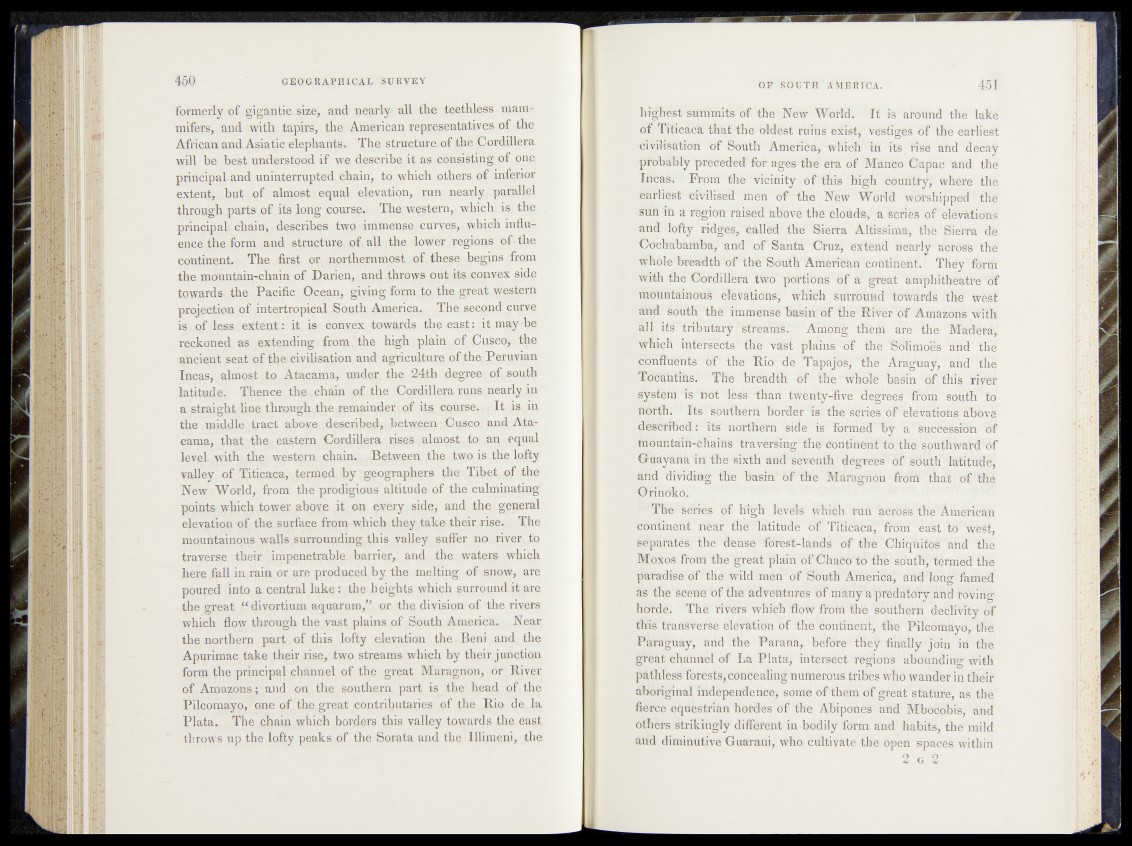
formerly of gigantic size, and nearly all the teethless mam-
ipifers,and with tapirs, the American representatives, of the
African and Asiatic ^^phants. The structure^of the Qprdillera
will be be&Lpnderstood if we. describe it asuconsisting of one
principal and uninterrupted chain, to which others of inferior
extent, but of almost equal elevation, run nearly parallel
through parts of its long course. The western, which is. the
principal chain,|describes two immense t curves, which influence
the form and structure of- all the lower regions qf-the
continent. The first or northernmost, of th e ^ begins from
the mountain-chain of Darien,, and throws opt ife.g^pvpx side
towards the Pacific Ocean, giving form to the grpa.t western
projection of intertropieal South America,rn The ^cqqd cuaye
is of less extent: it is convex towards tlm ep^f at.may he
reckoned as extending from, the high plain the
ancient seat of the civilisation and agriculture of the,Perpvi,ap
Incas, almost to Atacama, under the ,24th decree of south
latitude... Thence the^phain of the Cordillera runs nearly ip
a straight fine through the remainder of it^ coujcse, It is in
the middle tract above described,, between Cusco and Atacama,
that the eastern Cordillera rises almost to aq^equal
level with the western chain. -Between: ,i#
valley of Titicaca, termed by geographers the Tibet of the
New World, from the prodigious altitude of the culmipating
points which tower above it on every side, and the general
elevation of the surface from which they taketbeir rise. The
mountainous walls surrounding this valley suffer no river to
traverse their impenetrable barrier, and the waters which
here fall in rain or are produced by the melting of snow, are
poured into a central lake: the heights which surround it are
the great “ divortium aquarum,” or the division of the rivers
which flow through the vast plains of South America. Near
the northern part of this lofty elevation the Beni and the
Apurimac take their rise, two streams which by their junction
form the principal channel of the great Maragnon, or River
of Amazons ; and on the , southern part is the head of the
Pilcomayo, one of the great contributaries of the Rio de la
Plata. The chain which borders this valley towards the east
throws up the lofty peaks of the Sorata and the Illimeni, the
hi|he8t siitnmits of the New Woild. It is arotmd the lake
öf Titicaca that the oldest ruins exist, vestiges of the earliest
civilisation of South America, which in its rise and decay
probably preceded for ages the era of Manco Capac and thë
Incas. From the vicinity ^f this country, where the
earliest civilised men of the New World worshipped the
sun in a region raised above the clouds, a series of elevations
and lofty ridges, called the Sierra Altissinia, the Sierra de
Cochabamba, and of Santa Cruz, extend nearly ’across the
whole breadth of the1 South American continent. They'fbrth
with the Cordillera two" portions' -if a' gtMt amphitbtófe W
tóóütttainóuS èfevétiotis, which Su'iTOuftd towards the Wést
and idtith the ikmehsi hasift Wf the River W AmazOfië With
all its’ tributary WfreuiniLW Amóh^’ tbem $nre?lthe Maderfy
wTriclf' ihtersuètS-the vS¥t plain’!; uf thl^^fffifeoe! :and
cMfïuents!,ofr the Rio *3$ vTkpajd|fetberoAra’guay, ’"akef *tfl$
TM'ntihs. The breadth Of the whole basik of this rifbr
systerh fi! not less than twenty-five fli^ieëS^firorli south’; to
north. Its 'southern border is
described: its northern side is formed by a succession of
mountain-chains traversing the continent to the southward Of
Ouayana in the With1 and seventh degfëe!;'bf south latitude;
and dividing the basin of the Maragnon from that of the
©riïiökol I
The series of high levels which run across the UmO^eati
continent near thh’ datitüdè' Of Titiehêa*, froteff east to3 ’West,
separates the dense forest-lands of the Chiquitos and the
Möxos from the great plain of Chaco to the south, termed thé
paradise of the wild men ’ of B5uth AhiieHéa, afiddbA^ famed
as the' scene of the adventures of many a predatory and roving
horde. The rivers which flow from the southern declivity of
this transverse elevation of the continent, the Pilcomayo,the
Paraguay, and the Parana, befdre the^finally in thé
great channel of La Plata, intersect regions abounding with
pathless forests, concealing numerous tribes who wander in their
aboriginal independence, some of them of great stature, as thé
fierce equestrian hordes of the Abipones afid Mbocohis, and
others strikingly different in bodily form and habits, the mild
and diminutive Guarani, who cultivate the open spaces within
oA* hrr oAt